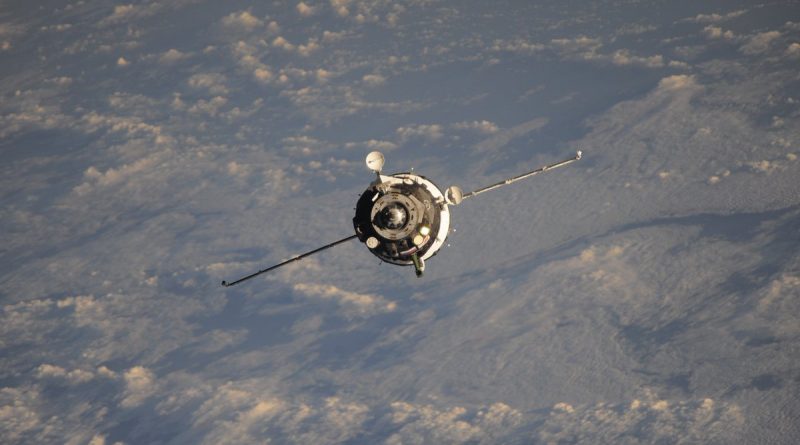ISS Welcomes Soyuz MS-04 & Two Crew Members after Speedy Rendezvous
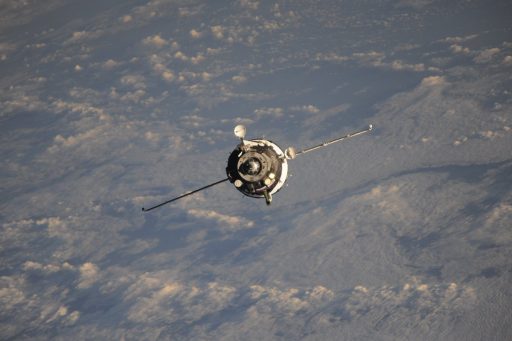
Russia’s Soyuz MS-04 spacecraft, carrying a reduced crew of two, chased down the International Space Station for a speedy rendezvous on Thursday, bringing its veteran commander Fyodor Yurchikhin and NASA Astronaut Jack Fischer to their orbital destination just six hours after blasting off from Kazakhstan.
Thursday’s express flight began at 7:13 UTC when Soyuz MS-04 took flight atop its Soyuz FG rocket, blasting off from the historic Site 1/5 launch pad at the Baikonur Cosmodrome on a nine-minute climb into orbit. Fifth-time space flier Yurchikhin and space rookie Fischer received a smooth ride atop the trusted Soyuz FG, checking off its 59th successful flight when the Soyuz spacecraft separated from its upper stage – trailing the Space Station by some 3,500 Kilometers at the moment of separation.
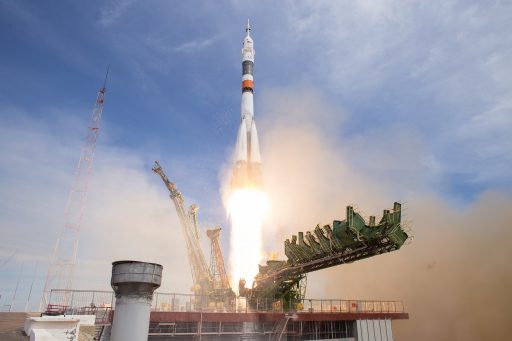
Setting sail on the first of over 2,000 orbits around Earth, Soyuz began executing a series of main engine burns to ascend from its initial orbit at 200 Kilometers to reach the Space Station that operates 400km above the planet. Overseeing a fully automated rendezvous, the crew pulled into their orbital parking spot just over six hours after lifting off to mark the start of a 136-day stay on ISS.
Soyuz MS-04, the 133rd Soyuz mission in a program that dates back to 1967, flew under Fyodor Yurchikhin’s call sign ‘Olimp’ (Olympus) and also carried the name Argo for the mythical Greek ship the Argonauts sailed on to retrieve the Golden Fleece, a symbol for authority and kingship. This is only the second Soyuz to be named, the first was Soyuz TMA-21 ‘Gagarin’ in 2011 to commemorate the 50-year anniversary of Yuri Gagarin’s historic mission. Commander Yurchikhin is hoping to start a new trend of selecting names for Soyuz spacecraft in addition to the serial numbers usually used to identify a vehicle.
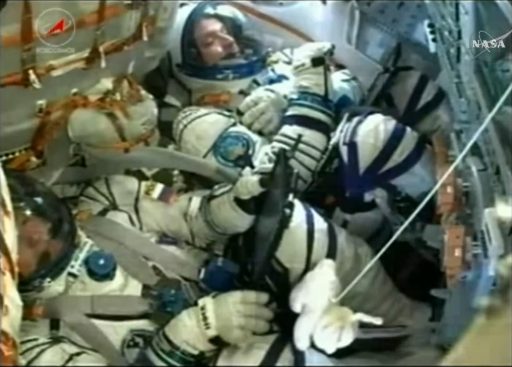
Gearing up for a same-day rendezvous, the Soyuz MS-04 crew duo was awoken at 4a.m. local time to begin a day of nearly 24 hours starting at the Cosmonaut Hotel with a final breakfast in the comforts of gravity and ending after a joint meal as a five-person crew in orbit, joining the resident Station crew members. The crew climbed into their Soyuz capsule two and a half hours before liftoff, taking their seats atop 274 metric tons of explosive propellants needed by the Soyuz FG to send the 7,200-Kilogram spacecraft into orbit.
Fyodor Yurchikhin, sitting in the commander’s seat in the center, was getting ready for his fifth mission into space after completing an ISS assembly mission on the Space Shuttle and flying as part of three long-duration crews, amassing 537 days spent in space and ranking 13th on the all-time list for career time logged in orbit. Jack Fischer, a test pilot in the U.S. Air Force, joined NASA in 2009 and was looking forward to his first ride to orbit.
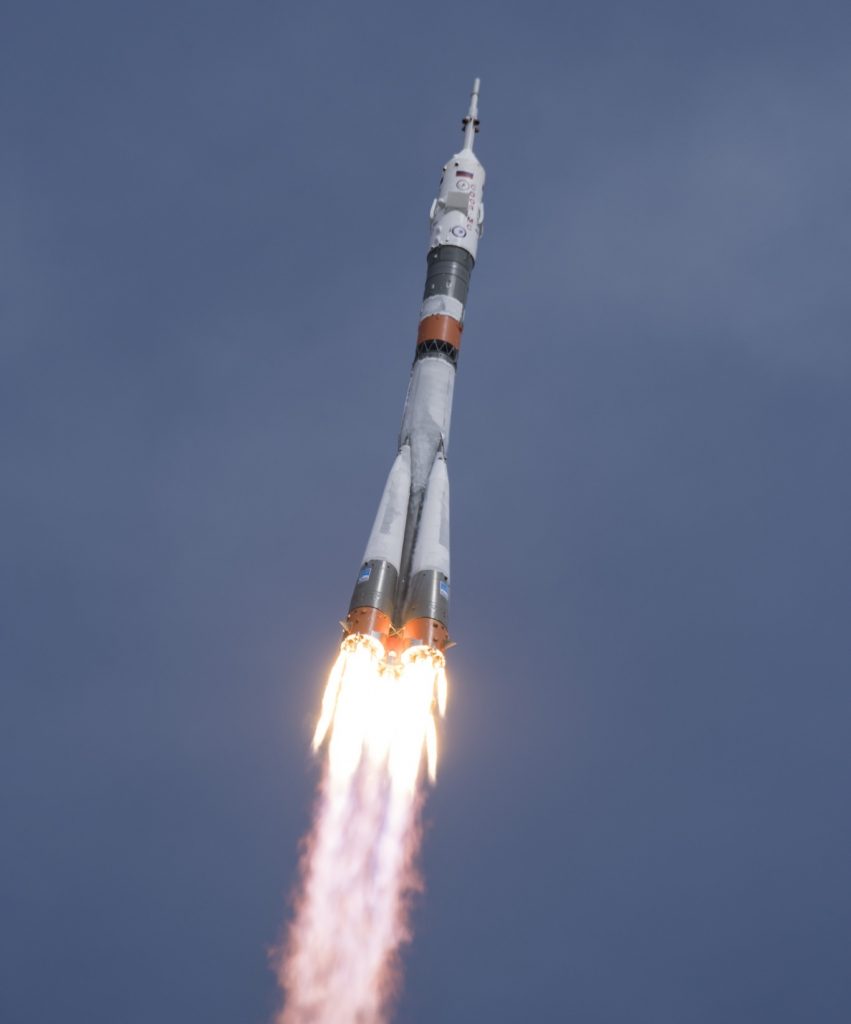
Soyuz came to life after an extremely clean countdown, soaring off at precisely 7:13:43.171 UTC under the loud thunder of its four boosters and core stage, giving the rocket a launch thrust of 422 metric-ton force. The 49.5-meter tall launcher swung to the north-east to begin chasing the Space Station that passed directly over the launch pad three minutes and 47 seconds prior to liftoff, pulling out in front of the Soyuz.
Soyuz dropped its four boosters one minute and 58 seconds into the mission after they helped lift the vehicle off the ground and accelerate it to a speed of 1.5 Kilometers per second. Powered by the core stage alone, Soyuz jettisoned the launch shroud two minutes and 37 seconds into the mission, giving Jack Fischer an initial view of Earth from his left-side window.
Reaching 160 Kilometers in altitude and a speed of 3.7 Kilometers per second, Soyuz shut down its core stage and fired up the RD-0110-powered Block I third stage at the same time the stage separation mechanism was initiated. The 30,400-Kilogram force engine burned for nearly four minutes and onboard video showed the familiar jolt at the moment of engine cutoff when raw rocket power transitioned to the sensation of weightlessness in the instant of a second.
The 7.5-meter long Soyuz craft separated from its carrier rocket eight minutes and 48 seconds after liftoff, entering the fast lane to the International Space Station after a picture perfect launch that put the Soyuz into an orbit of 199.9 by 257.4 Kilometers, per the Russian Mission Control Center TsUP.
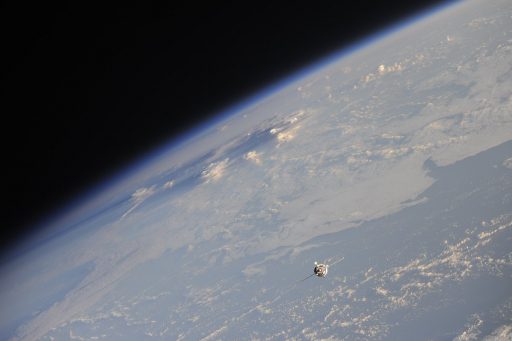
Soyuz MS-04 was the first in the improved MS series of spacecraft to utilize the express rendezvous profile taking Soyuz from its launch pad to the Space Station in just four orbits. Inaugurated in 2013, the fast-track rendezvous was unavailable for the first flights of the new Progress MS and Soyuz MS vehicles because a ground station in Russia’s far east – responsible for covering the first minutes after separation from the rocket – had not finished outfitting with S-Band uplink equipment compatible with the new Unified Command and Control System of the MS-class vehicles.
Heading off on its first lap around the planet, Soyuz was set for a pair of engine burns to begin raising its orbit straight away due to the compressed timeline of the rendezvous. Taking place 42 and 80 minutes into the flight, the two engine burns were to deliver a change in velocity of 21.6 and 23.9 meters per second, respectively, and were programmed into the spacecraft prior to launch. Re-appearing over Russian Ground Stations, Fyodor Yurchikhin reported two good burns and Soyuz was provided with recalculated parameters for the DV-3 and 4 burns based on actual orbital parameters to position the craft for the automated rendezvous.
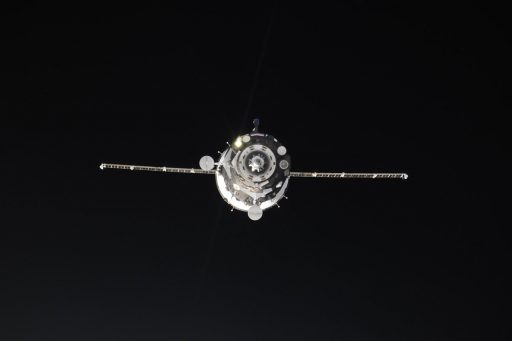
With good checks of the KURS navigation system and a manual flying exercise completed by Fyodor Yurchikhin, Soyuz was approved to continue with the four-orbit rendezvous. The Automated Rendezvous Sequence kicked in at 11:12 UTC and Soyuz carried out its final ground-targeted burn a few minutes later to enter a path into the 200-Kilometer communications zone around ISS.
The KURS-NA radio navigation system on the Soyuz craft and its counterpart on ISS were powered up at 11:45 UTC and Soyuz employed its new AO-753A phased array antenna to search for the signal direction of ISS. Once locked onto the signal, KURS provided line-of-sight and pitch angle measurements until, at closer range, the ASF-1 antenna became active to deliver range and rate measurement in addition to the angular information.
With its destination in view, Soyuz executed a series of rendezvous maneuvers and automatically checked the validity of data delivered by the KURS System – all under the watchful eye of Fyodor Yurchikhin who was ready to intervene at any point in case of an anomaly.
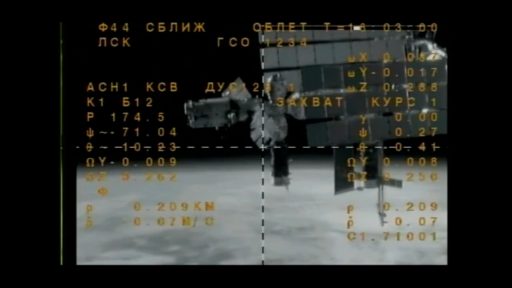
As the Space Station grew in size as seen through the external TV camera of the Soyuz, the spacecraft maneuvered to reduce an initial targeting offset and hit the brakes to set up for the flyaround maneuver that started at a distance of 400 meters and was designed to transition the Soyuz from a path approaching ISS from behind and below to a straight-down approach to the Poisk Module.
Soyuz remained rock solid throughout the flyaround, closing in to 180 meters and executing a roll maneuver to position its solar arrays for the docked mission. The spacecraft then came to a halt in perfect alignment with its docking target, allowing Yurchikhin to send commands for the final approach of the spacecraft. Using its DPO thrusters, the Soyuz remained on course to Poisk and slowed to a glacial speed of 0.1m/s while the Docking Mechanism powered up to be ready for contact.
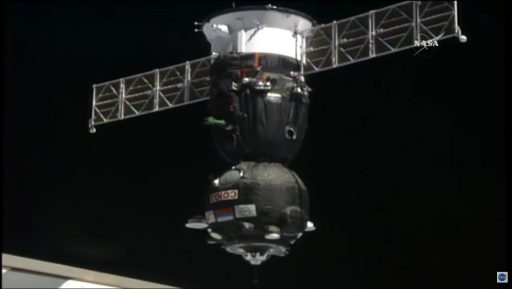
Contact and Capture was confirmed at 13:18 UTC while ISS was flying 400 Kilometers above the Atlantic Ocean, marking the arrival of the Expedition 51/52 crew at their home in space for the next four and a half months.
Upon sensing contact, Soyuz automatically fired up its thrusters to push in so that capture latches would engage. Meanwhile, the Space Station headed into free drift to allow relative motion to dampen out ahead of the retraction of the Soyuz docking probe and closure of the hooks to fully secure the structural connection and form the pressure tight seal between the two spacecraft.
Up next for the crew was a trial of their patience, having to work through 90 minutes of methodical leak checks, first verifying the internal integrity of the Soyuz capsule before pressurizing the vestibule between the spacecraft and ISS for an hour-long leak check to verify the seal is holding pressure. While keeping an eye on the pressures, the two crew members will change into comfortable flight suits after having been in the Sokol Launch and Entry Suits for over 11 hours.
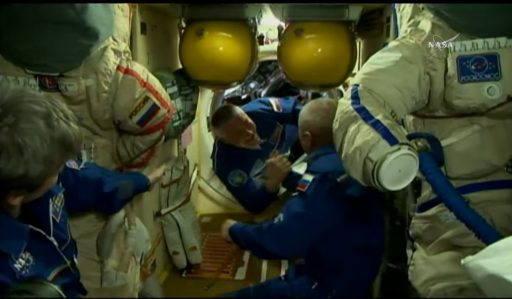
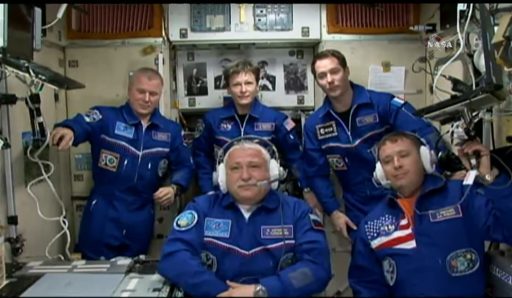
Hatches between the Soyuz and ISS swung open at 15:25 UTC to mark the return of Fyodor Yurchikhin to what will surely be a familiar environment for him after spending one and a half years on ISS on his previous missions. Jack Fischer traded the confines of the Soyuz for the comforts of ISS for the first time.
The assembled crew gathered inside the Zvezda module for the traditional video conference with their families who followed the progress of their journey from Baikonur after seeing them launch into space.
To round up a very long day, the crew will walk through a detailed safety briefing and set up their crew quarters on ISS after deactivating the Soyuz spacecraft.
Both men launched on Thursday are looking forward to an eventful mission filled with world-class science performed aboard the orbiting laboratory as well as spacewalks to outfit the exterior of the complex for future operations. Yurchikhin and Fischer will join the Expedition 51 crew of Commander Peggy Whitson, ESA Astronaut Thomas Pesquet and veteran Cosmonaut Oleg Novitskiy for six weeks of five-crew operations that will see the arrival of a commercial resupply craft, the deployment of over 30 satellites and a U.S.-based spacewalk by Whitson and Fischer on May 12.
Peggy Whitson, NASA’s most experienced female astronaut, will surpass Scott Kelly on April 24 and take the record for most days spent in space by an American Astronaut. She plans to switch from the Soyuz MS-03 crew over to the MS-04 spacecraft to extend her stay aboard ISS from an early June departure to September to keep an extra pair of hands on station and avoid an extended period of two-crew operations in the summer.
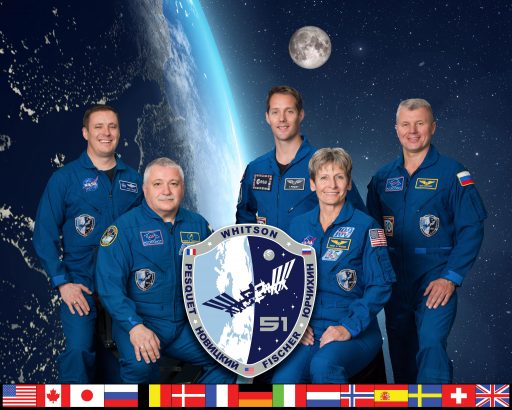
Whitson, Yurchikhin and Fischer will have the station to themselves from June through late July, overseeing the arrival of the next SpaceX Dragon and a Russian Progress supply vehicle while also supporting dozens of experiments underway aboard ISS at any given time. Sergei Ryazansky, Randy Bresnik and Paolo Nespoli will arrive on July 28 to restore the Station’s crew to six – now with four USOS residents and two Russian crew members. Ryazansky and Yurchikhin will venture outside on a spacewalk in August, marking the first Russian EVA in two years and debuting new space suits
The crew’s focus will be on science – 216 experiments will be conducted aboard the U.S. Segment over the course of Expedition 51/52, covering virtually all branches of science. For many of them, the crew members themselves will act as test subjects to learn about the effects of the space environment on different bodily systems – knowledge that is required to achieve longer and longer mission durations through the implementation of improved countermeasures preventing the negative effects of space radiation and microgravity-induced bone & muscle loss.
Per the current schedule, Soyuz MS-04 with Yurchikhin, Fischer and Whitson will depart ISS on September 3 to head toward a parachute-and-rocket-assisted landing in the steppe of Kazakhstan after a flight of 136 days for Yurchikhin and Fischer and 289 days for Whitson.

